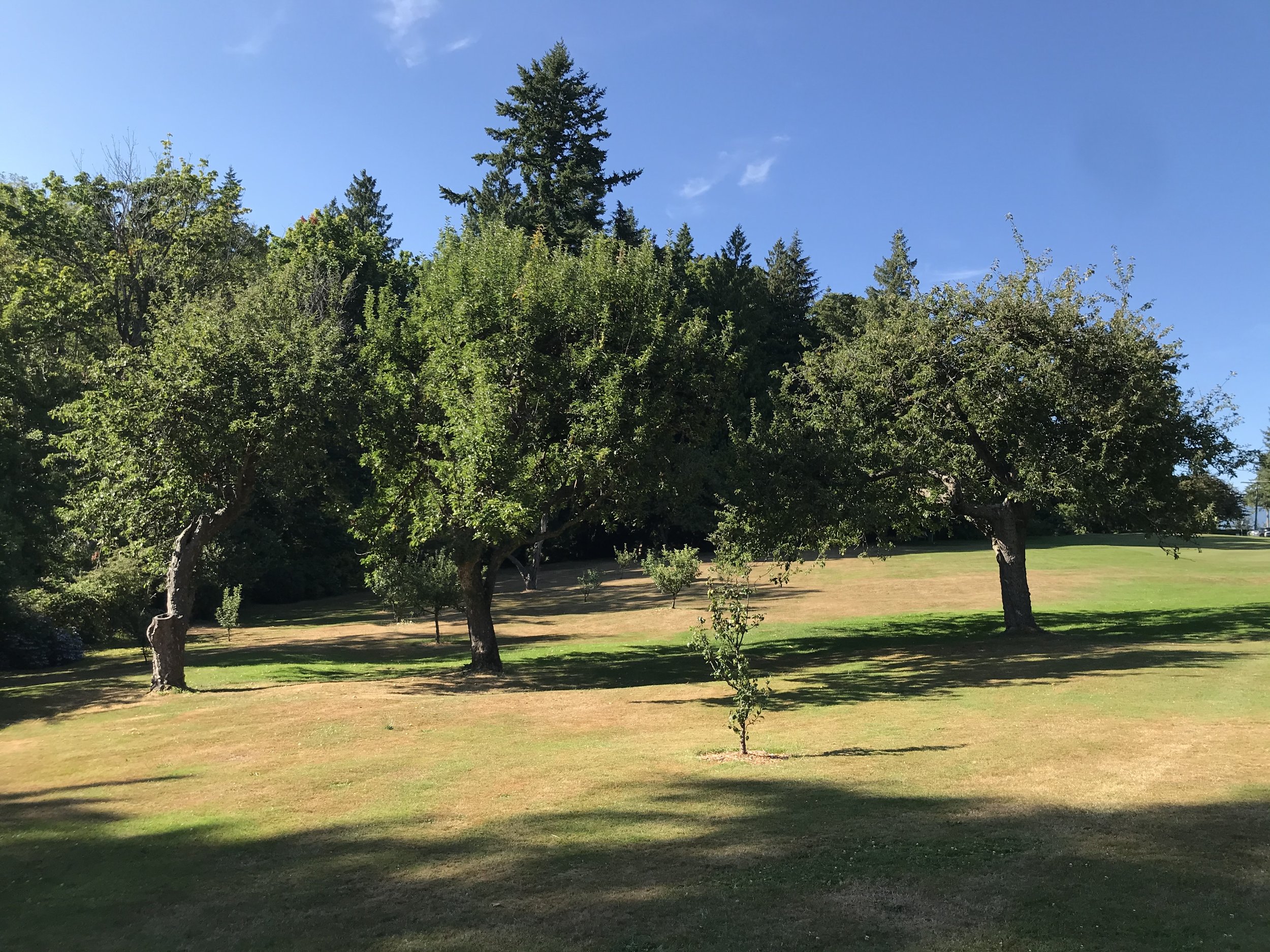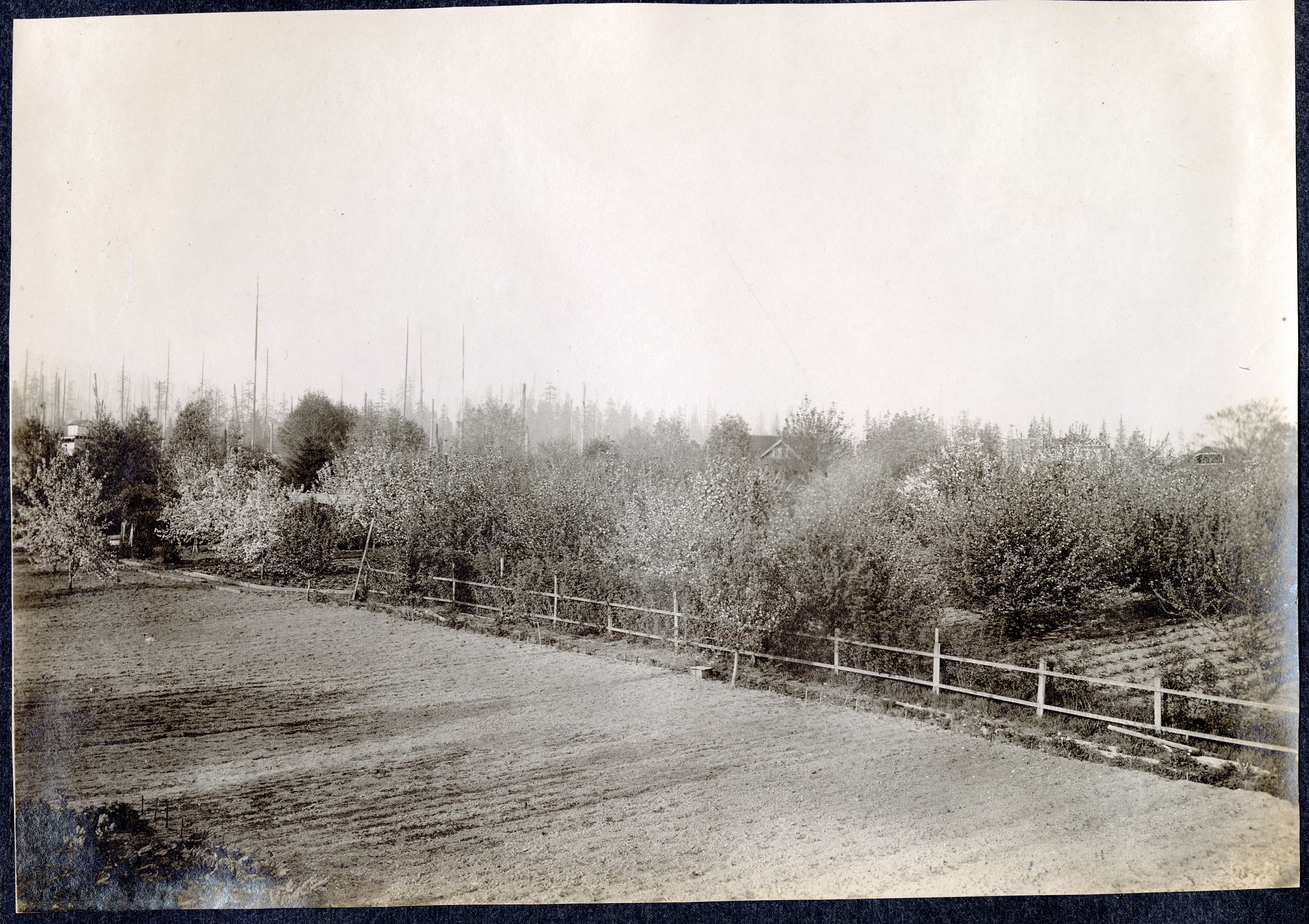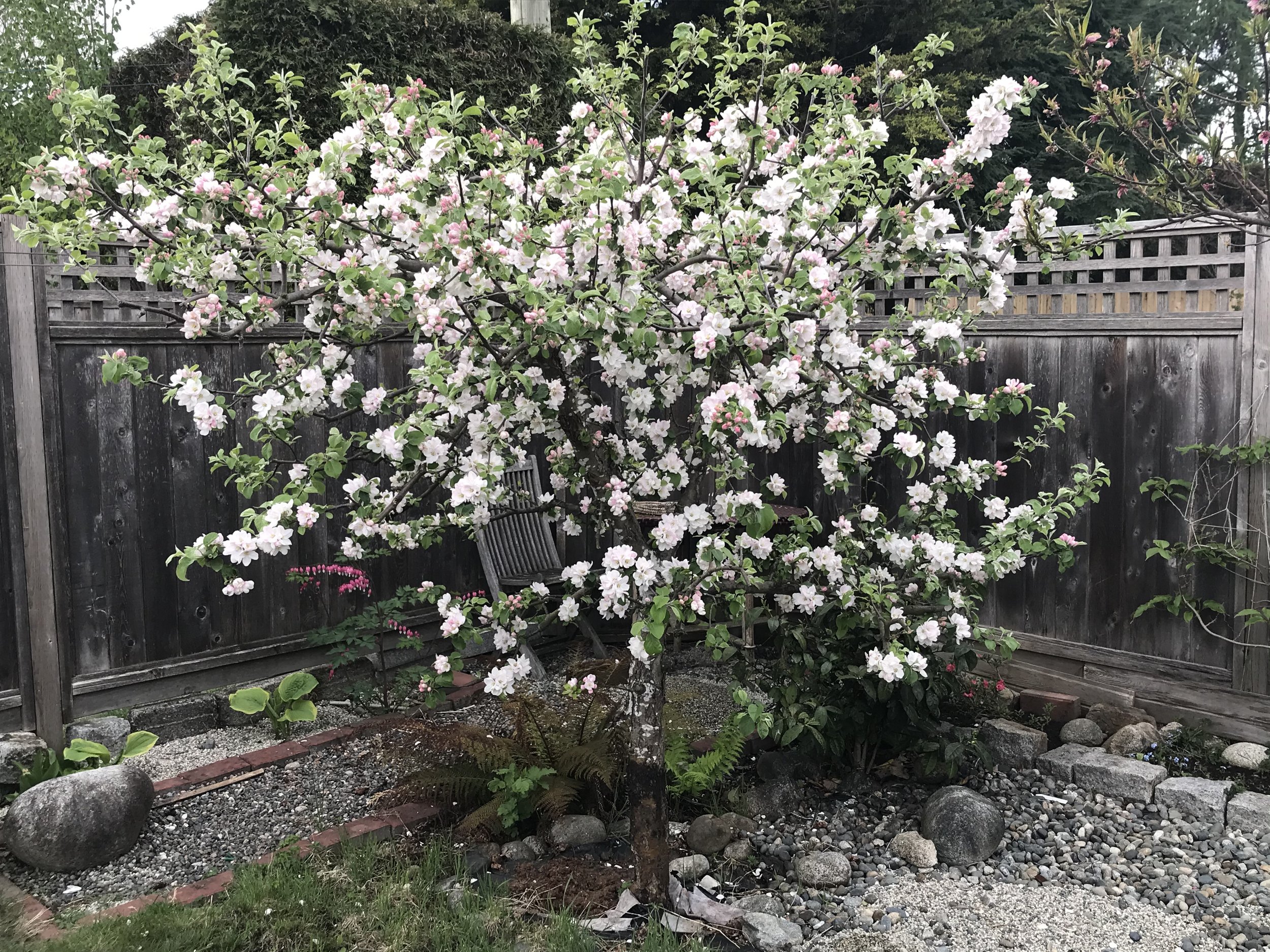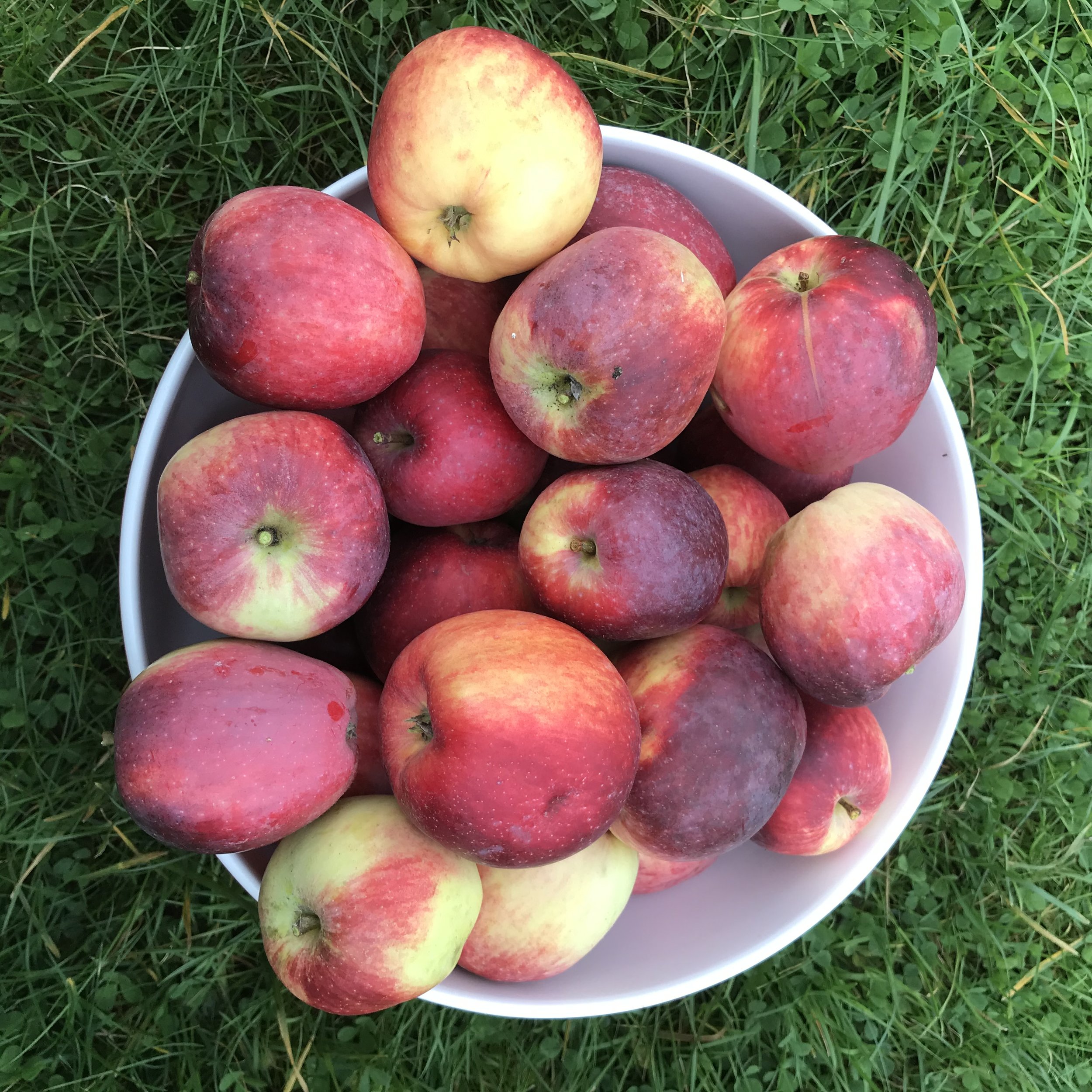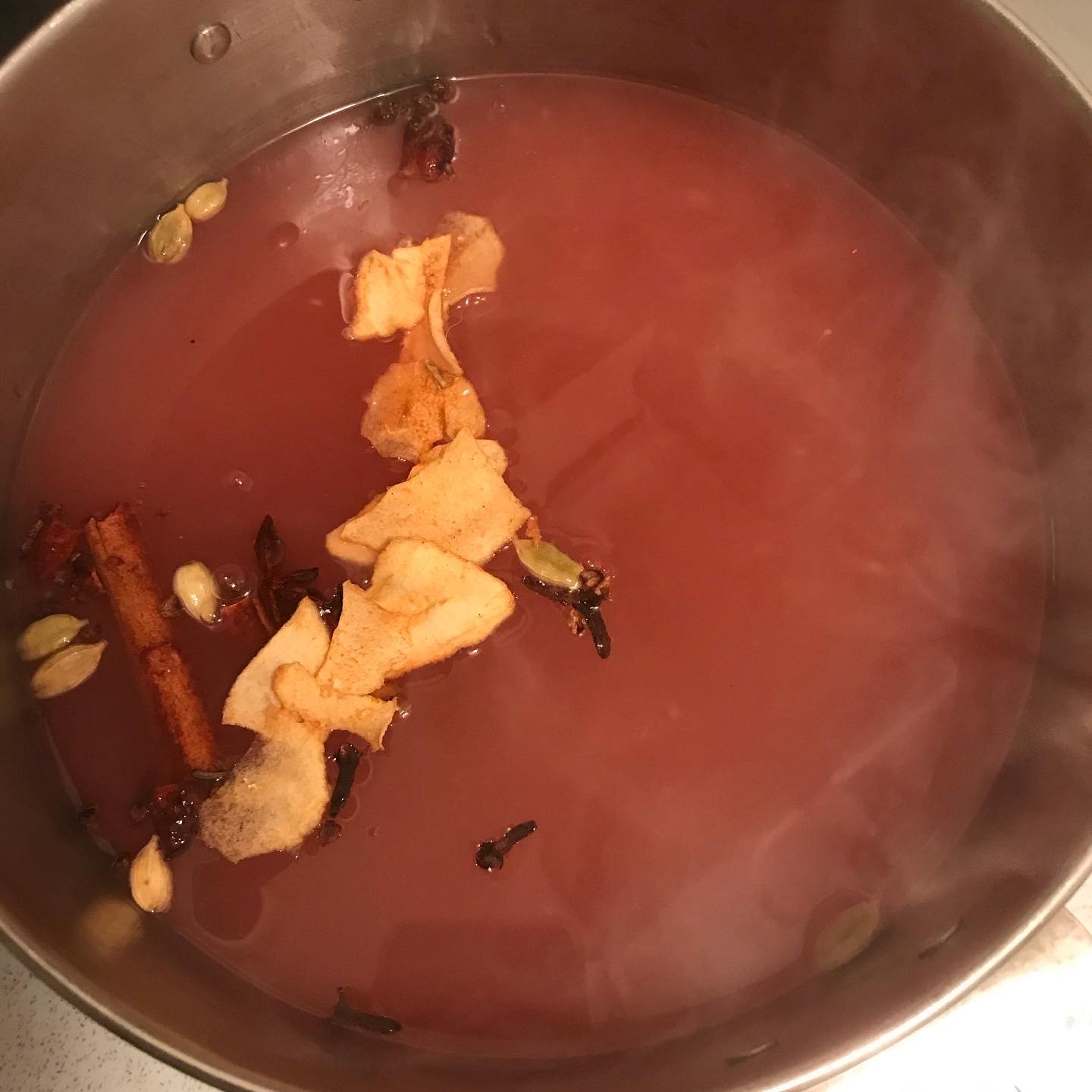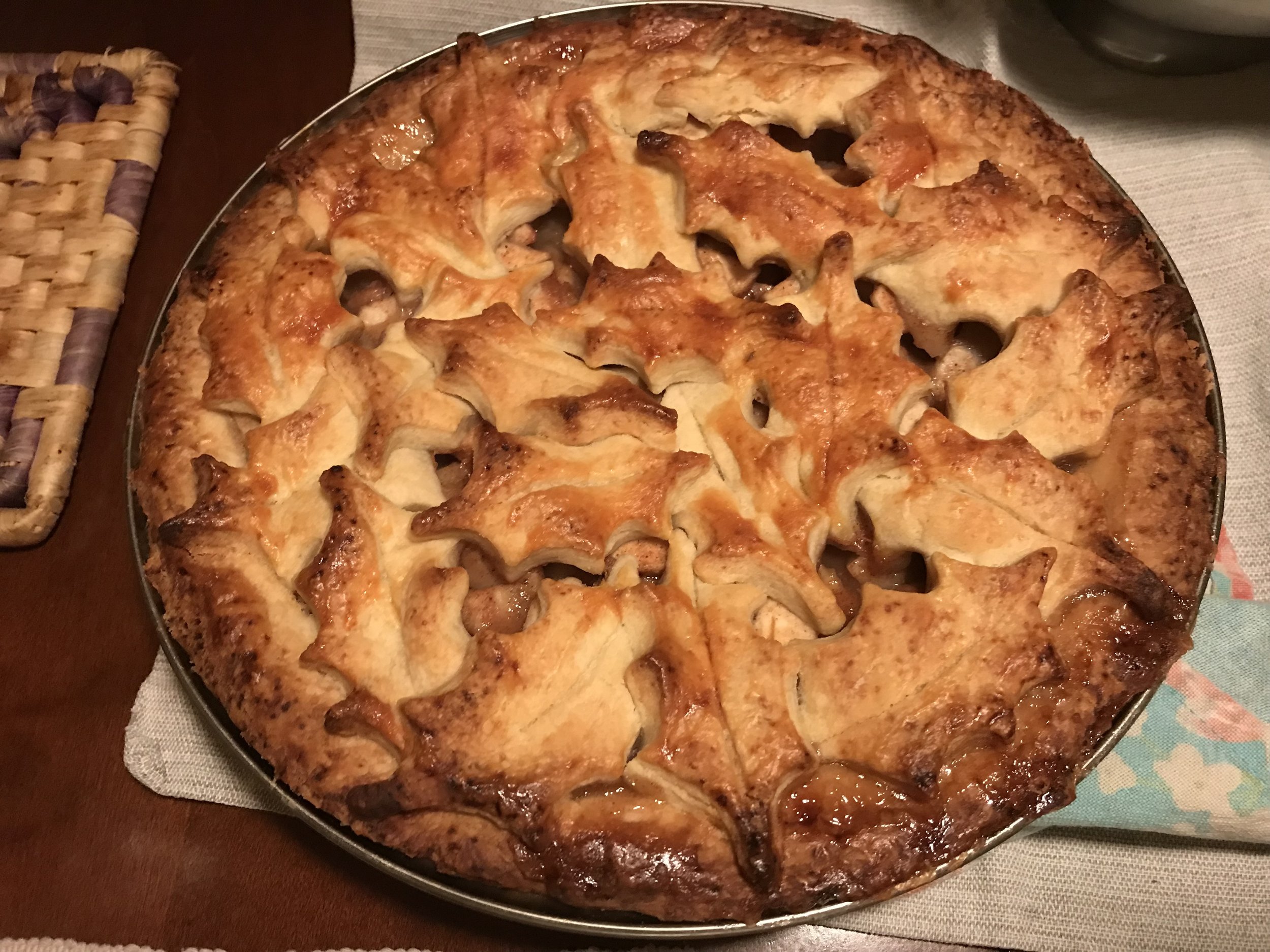The humble apple, readily available in every grocery store year-round, and not thought of as an exotic fruit by any stretch of the imagination, is easily taken for granted - but don’t be fooled; this fruit has a long and incredible history, and is wondrous in so many ways that I think the trees that produce apples are worth preserving and learning about. But before I get into our local history, I’d like to share some of the apple tree’s history to give you an appreciation for how far-reaching in time and space the story of the apple goes and how it made its way into our present and historical orchards and kitchens.
Photo by Jenny Morgan
Originating in its early form in Kazakhstan between seven and nine million years ago, apples have been eaten by humans and animals since prehistoric times. According to researcher Robert Spengler, they are thought to have been spread across Europe and Asia by “megafauna”, very large, now extinct animals, such as giant horses during the Pleistocene - also known as the Ice Age - which ended around 11,700 years ago. Pockets of land remained warm enough that some apple trees survived. Thousands of years later, the cultivation and genetic evolution of desirable varieties from these pockets was further hastened by farmers and traders hybridizing apples by grafting, and then transporting them East and West along the Silk Road. They eventually made their way across Europe and Asia and became popular in Northern Europe before Colonial times. Thus, by the time Colonialism began spreading people around the world, many of these people brought their favourite apple varieties with them. The versatility, health benefits and pure deliciousness of eating apples made them important enough to bring to the New World.
When I imagine the long and difficult journeys that many of these settlers made by boat, it makes the bringing of these little apple trees (or carefully cut branches kept in moist soil until grafting was possible) even more remarkable since many people brought so little with them on the journey. They needed to bring trees or potted branch cuttings rather than seeds because apple trees are special in that they can’t reproduce themselves faithfully from their own seeds.
This is because apple seeds are a product of the pollen of two, or sometimes even three, different apple trees; therefore the offspring of that seed can’t produce the same type of apple and usually produce a small, bitter crab apple (or “spitter” as they are often called) rather than a juicy eating apple. The only way to reproduce the same variety is by grafting a piece of it onto another rootstock. As for the seeds, only one in every 10,000 or so seeds actually produces an eating apple, and this will be a new variety of apple every time. When this happens, it’s like winning the apple lottery!
The old apple trees on our North Shore, (and everywhere they grow for that matter) are special because of the fact that every single one is from a branch that was grafted over and over, possibly many hundreds or even thousands of times from the original tree it came from. This makes them all “heritage apples” in a very physical way, along with the history associated with the growers of the trees. The stories that could be told if one could trace history through all the people that grafted trees from each other!
Apple growing as a BC business was promoted widely in local newspapers in the early part of the 20th century and, until orchards became very large and popular in the Okanagan, pushing out some of the smaller growers, they were generally a good way to make money all across the South Coast of BC, including all over the Lower Mainland, Vancouver Island and the Gulf Islands. The North Shore used to have a number of beautiful orchards planted by settlers, and, although I couldn’t find specific historical references to any local orchards as businesses aside from Moodyville’s Tom Turner, a number of them were of a good size and may well have been money-makers rather than just homesteads. Certainly they were used by their owners to feed themselves, and in some cases like the Fromme orchard, they fed the workers of the landowner as well.
The earliest orchard on the North Shore was planted in the mid-1800s, and I found references to orchards into the 1920’s, but, as development rapidly encroached into the wilderness, it began to take with it land with orchards on it, and mention of orchards became more and more sparse in newspapers and historical documents as time went on. The North Shore has a wealth of wild nature and parkland surrounding it and within it, but there seems to have been little zoning provision for maintaining agricultural land as it developed, so houses and commercial property took precedent over the orchards and farmland.
There are remnants left here and there of North and West Vancouver’s large, old orchards, and some small, backyard ones, but nothing more. Fortunately, a number of school and community gardens - some of them with the help of folks from the Edible Garden Project - are including pockets of fruit trees in their gardens that will hopefully become some of the heritage orchards of the future. It’s heartening to see a renewed interest in orchards, but what precious little we have left of the old apple trees should also be preserved as important pieces of living history.
I came across references to a number of historical orchards in my research that I had never heard about. Each orchard was planted by a significant figure in the development of North Shore communities. Here is a sampling:
NORTH VANCOUVER
J. M. Fromme estate: the owner of the Lynn Valley Lumber Co. and the “founding father” of Lynn Valley, Fromme built the first “house” ( as opposed to a cabin or shack) in Lynn Valley around 1900 and planted an orchard that was between his house on Ross Rd and Hastings Creek nearby. At some point he donated part of the orchard to the Presbyterian Church which is the current site of Maple Leaf Garden Centre on Mountain Highway.
Fromme Orchard west of house between Ross Rd. and Hastings Creek. Orchard had about 40 trees. 192-
Courtesy of MONOVA:Archives of North Vancouver, ref. #6980
Tom Turner’s orchard, Moodyville. (present day Lower Lonsdale).
In the 1880s, the area which is roughly where Lonsdale Quay and Waterfront park now stand, was Tom Turner’s farm. It was a large piece of grassy land-the only large, grassy area in North Vancouver at the time- which had its own vegetable garden, orchard, barn and farmhouse. The land was cleared in the 1860s and apple trees were planted, and by the 1880s, when Tom took it over from his uncle, he began supplying fresh produce to the nearby Moodyville Mill. Because this was the only park-like space in North Vancouver-the rest being full of either trees or tree stumps- Tom’s land became an unofficial park and popular picnic spot for locals. Tom was also active in the community as a city councillor.
Men and women in tree in Tom Turner's orchard, Moodyville (North Vancouver) ca. 1890. Courtesy of the Vancouver Archives, ref. # SGN 347 (created by Major James Skitt Matthews)
Cottages and tents on Tom Turner’s orchard, Moodyville, (North Vancouver) ca. 1890. Courtesy of the Vancouver Archives, ref. # SGN 348 (created by Major James Skitt Matthews)
1500 St. Georges (Keene Estate): Was originally the home of Mr. W. Keene, a North Vancouver police commissioner, and his family. He was one of the earliest pioneer residents of North Vancouver, already a resident in the late 1800s and an active member of the Lonsdale community. He was a fruit tree expert who lectured and wrote about them and he also helped design the local Horticultural Hall which opened in 1908. In 1909 he was elected president of the North Vancouver Horticultural Society. There was a large orchard on his substantially-sized property. The property now houses a large, multi-unit condo building with Lions Gate Hospital across the street. There are a number of trees around the building but no trace of the orchard which likely was partly where the hospital now stands.
Orchard, Keene Property, 1500 St. Georges. Courtesy of MONOVA:Archives of North Vancouver, ref. # 4081
WEST VANCOUVER
Navvy Jack House/Hollyburn House: John Lawson, the “Father of West Vancouver” bought the house, once owned by the “Navvy Jack” Thomas and his family, in the early 1900s. Built around 1870, it was the oldest continuously inhabited home in the Lower Mainland until its somewhat recent vacancy. Lawson planted an orchard between his home and his real estate office a little ways east from his house. There are no remnants of the orchard left. The house’s future is still somewhat uncertain, despite great efforts to save it. Hopefully it can still be preserved.
John Lawson property at the foot of 17th Street, ca. 1913, as seen from the pier. The Lawson family home, Hollyburn House, is at left. The house was also known as the Navvy Jack Thomas house. The building at right was the Lawson Real Estate office. Between the two buildings is an orchard. People can be seen walking north on the pavement beside 17th Street, known at the time as Lawson Avenue.
Photo courtesy of West Vancouver Archives, ref. #0027.WVA.RAH and is part of the Rupert Harrison photograph collection
Olde Caulfeild: On Pilot House Road in a grassy area by the plaque honouring Francis Caufeild is an old apple tree. I’m guessing it was one of many that were planted during Caulfeild’s conception since residents of Caufeild were generally avid gardeners. This tree is no longer fruiting which makes it likely that it’s quite old.
“If I knew the world ended tomorrow, I would plant an apple tree today.”- Martin Luther
Photo by Jenny Morgan
Overgrown orchard in Olde Caufeild. I couldn’t tell the age of it, although the house on the property looked like it was from the 1940’s or 1950’s, and the trees were still producing. You can see one old tree in the centre of the photo peeking over the fence and there were a number of other old fruit trees there as well. The fence was covered with an old grapevine just out of view. Photo by Jenny Morgan.
Gleneagles Golf Course sixth hole: This land was originally a ranch with an orchard grown by pioneer Peter Larson around 1900. It was sold in the 1920s and developed into a golf course and country club, but a number of trees from the original orchard at the 6th hole remained. New ones have been grafted and planted at the site as part of a partnership with UBC to keep the orchard going and preserve the rare varieties of apple trees growing there. Anyone golfing in the fall during apple drop has an extra challenge to find the ball if it ends up under one of the mature apple trees!
Pete Larson's Ranch. View looking down to Larson Bay with an orchard on left ca. 1927. (created by W.J. Moore) Courtesy of West Vancouver Memorial Library digital collections, ref. #0050.VCA
Present day view of orchard looking SW with old trees mixed with young, grafted specimens planted with help of UBC to preserve these rare species. Photo by Jenny Morgan
Large, old apple tree in the middle of the 6th hole. Amazingly, it’s still producing apples as you can see from the next photo. Photo by Jenny Morgan
Photo by Jenny Morgan
I’m very fortunate to have a little house with a big backyard and I’ve been growing apple trees since we moved here twelve years ago. They have been one of the biggest blessings of this property and I live for spring when the glorious blossoms come out and then September and October for harvest time when my family and I eat them fresh, tart and juicy, and make homemade juice, apple wine, dried apples, apple sauce, and bake many, many delicious recipes with them. During the Christmas season we make hot, spiced apple juice from juice we’ve frozen and the smell just fills the house with coziness.
I grow trees on a semi-dwarf rootstock since they produce fruit more quickly and are smaller so that they fit in a city lot, but ideally, if one has the space and time to wait four to seven years for the first apples, a full size apple tree is a worthy investment for your future and the future of the homeowners who will one day live in your home, as they can live an average of between 30-45 years and up to around 100 years! My semi-dwarves may only live about 20-25, but before they die, I’ll graft more trees from my old ones and plant them so they can live on. If you choose to grow an apple tree, consider trying a rare variety and be a part of preserving and continuing the amazing story of the apple tree.
Do any of you readers have an old apple tree in your own yard, in your neighbourhood or are planning on growing one? Do you have any fond memories of growing or picking apples on the North Shore?
FUN FACTS
There are currently around 7500 varieties of apples grown worldwide. Many more varieties have disappeared over the ages as certain “supermarket” varieties became popular for their good looks and saleability, resulting in fewer varieties being grown.
The first orchards on B.C.’s coast were planted by settlers in the Gulf islands as early as the 1850’s. These settlers came from all over including Hawaii, Europe and some were former African-American slaves. There are still a number of orchards in the Gulf Islands.
A few varieties grown in BC that are lesser known and not seen often, if ever, in your local stores are Salish, Chehalis, Liberty, Doctor Matthews, Altlander Pfannkuchenapfel, Nicola, Bell de Boskoop, Blue Peamain, Rose du Kluj
More than one billion apples are grown in BC each year
Crabapples are the only type of apple native to North America. Our eating apples were all brought here from overseas.
The old saying, “An apple a day, keeps the doctor away” comes from an old English adage, “To eat an apple before going to bed, will make the doctor beg his bread.”
Links for further reading:
Heritage Apple Orchard (Derby Reach Regional Park)
Mother Jones article "Why Your Supermarket only carries 5 Kinds of Apples"
Sources: The North Shore News, newspapers.com, West Vancouver Memorial Library Digital Collections, West Vancouver Archives, MONOVA Archives, Vancouver Archives, DW.com, roadtrippers.com, nvrc.ca, Live Science magazine, University of Illinois Extension, Salt Spring Apple Co., evelazarus.com, lowerlonsdale.ca

